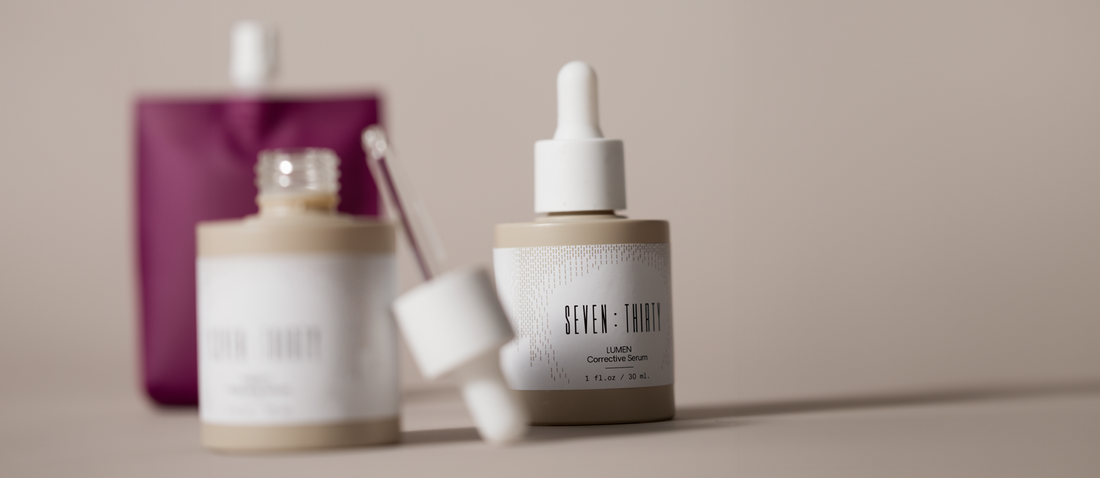You’ve heard of hyaluronic and maybe even glycolic acids and how they can benefit your skin. A lesser-known acid on the skincare scene? Mandelic acid.
The acid (which comes from almonds, as “mandel” is the German word for the nut) is a gentle alpha hydroxy acid (AHA) used in some skincare products. Like other AHAs, mandelic acid helps loosen or exfoliate the outermost layer of your cells.
It’s becoming increasingly popular in skincare products because it can help reduce the effects of aging and improve the skin’s overall appearance. Adding mandelic acid to your routine may be the missing puzzle piece you’ve been searching for, thanks to its versatility and potential skin benefits. Discover the wide variety of mandelic acid benefits, from helping the appearance of acne, hyperpigmentation, and more.
What is Mandelic Acid?
It helps to think of mandelic acid as a chemical exfoliant. It can remove dead skin cells faster than your body’s natural processes, which tend to slow down as you age. Chemical exfoliants can help even your skin tone and promote a vibrant skin texture.
Using products with mandelic acid, like serums or exfoliators, as part of your skincare regimen is a beneficial choice for many skin types. It’s a gentle AHA, making it a go-to choice for those with a sensitive skin type.
Mandelic acid also contains larger molecules compared to other AHAs, which means it is usually absorbed more slowly and may cause less skin irritation compared to other AHAs.
Unlike other skincare ingredients, almost anyone can test the potential advantages of using mandelic acid serums. These products are often safe for people experiencing:
- Rough and dry skin
- Acne and oily skin
- Wrinkles and fine lines
- Hyperpigmentation
Mandelic acid offers many advantages that almost anyone can experience when using these products.
How Mandelic Acid Can Benefit Your Skin
From acne scars to dark spots, mandelic acid benefits are far-reaching with a wide array of applications in skincare. Here are just a few ways you can use mandelic acid to your advantage:
Exfoliation
Mandelic acid is an exfoliant—which as you may already know, can be used to clear your skin of dead skin cells and other build-up. Regular exfoliation can help your pores stay clean to maintain a healthy complexion and avoid breakouts.
Acne management
Many people with acne-prone skin find that mandelic acid is a beneficial tool in their skincare toolkit. It may help unclog pores, dissolve blackheads, and control excess sebum production. Its antibacterial properties may help reduce acne-causing bacteria on your skin.
Hyperpigmentation
Mandelic acid may aid your skin in restoring hyperpigmentation, reducing spots from sun damage or age, and even correcting uneven skin tone.
In addition, mandelic acid may also have the power to soothe the skin post-shave and reduce the inflammation and redness from rosacea, thanks to the acid’s antifungal properties.
Potential Side Effects of Using Mandelic Acid
As with any skincare ingredient, mandelic acid poses a risk for potential side effects. Common symptoms associated with usage include signs of irritation, such as:
- Itching
- Flaking or peeling
- Swelling
- Dryness
- Redness
If you notice these side effects, give your skin a break from using the product. Some people experience over-exfoliation from using mandelic acid serums, which can lead to irritation or breakouts.
Patch Tests and Sun Care
When you use serums that have mandelic acid, you should start by doing a patch test on the skin before applying it to your whole face.
We recommend applying a small amount near your jawline about 24 hours in advance of regular use. Contact your healthcare provider or dermatologist if you notice any adverse effects, including irritation, a new skin condition, or an allergic reaction.
Once you’ve determined that mandelic acid is safe for your skin, you can incorporate it into your daily routine. As with many products that include alpha hydroxy acids, applying sunscreen and avoiding direct sunlight when using these products is recommended as well.
How to Use Mandelic Acid
When you’re ready to try a mandelic acid serum (like the LUMEN Corrective Serum), you can start in the morning. A typical regimen looks like:
- After washing your face, put three or four drops of the serum on your fingertips and gently massage the skin.
- Do this every other day for the first two weeks of use.
- You can use the serum daily if your skin maintains hydration after 14 days.
If you notice your skin drying out or becoming irritated, it’s beneficial to stop using it and give your skin a break. You may need to reduce the number of times you apply the serum per week if you have higher skin sensitivity.
Unlock the Power of Mandelic Acid with Seven:Thirty
Whether you experience hyperpigmentation or want to reduce fine lines, mandelic acid can help you reach the results you’ve been waiting for.
Seven:Thirty has created an inflammation- and pigmentation-reducing serum for all skin types with our LUMEN Corrective Serum. We use only the best ingredients and avoid animal testing, parabens, and SLS.
Shop our mandelic serum—and full product lineup—to stack your skincare routine with clean, quality ingredients that work for you and your skin type.
Sources:
Medical News Today. What is mandelic acid? https://www.medicalnewstoday.com/articles/mandelic-acid
WebMD. Are There Health Benefits to Mandelic Acid? https://www.webmd.com/beauty/health-benefits-mandelic-acid
Heathline. Benefits and Uses of Mandelic Acid. https://www.healthline.com/health/mandelic-acid#uses
Allure. What Is Mandelic Acid? Here's Everything You Need to Know About the Ingredient. https://www.allure.com/story/what-is-mandelic-acid

